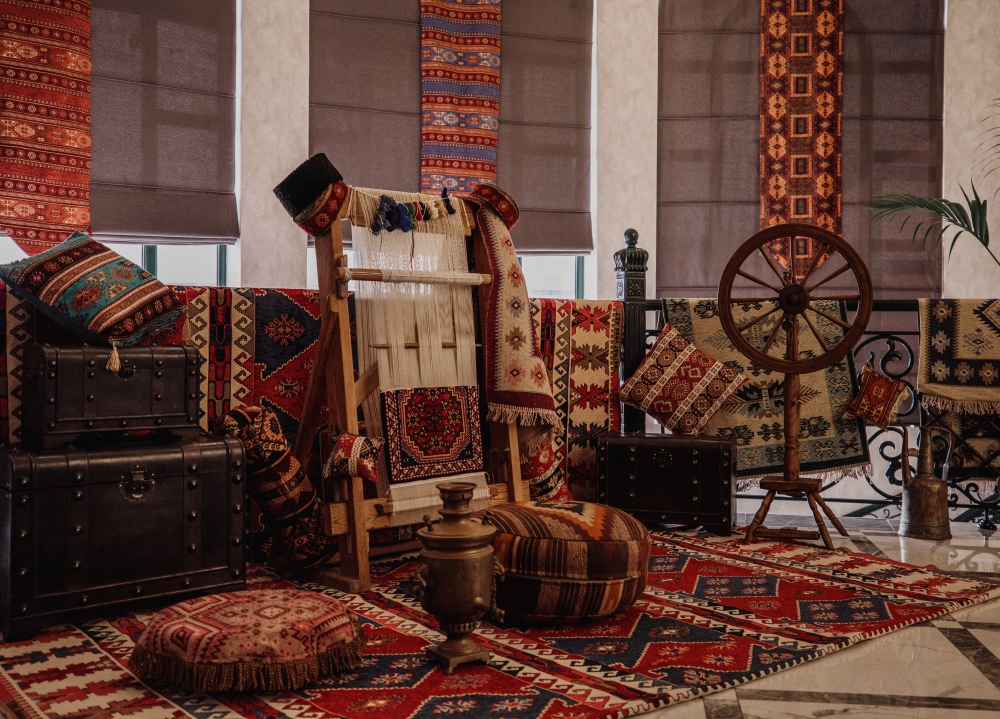The world of handmade rugs ar filled with unique terminologies, stories, and characteristics. One of them is “abrash,” but what is abrash and what does it mean. To many, these might appear as inconsistencies or flaws, and for some area rugs, they are. However, in the realm of antique rug connoisseurs and natural dye enthusiasts, abrash is a mark of authenticity and adds depth to a rug’s story.
What is Abrash?
Abrash stems from the Persian word for “mottled,” which aptly describes its appearance. In its most basic definition, abrash refers to the color variations or tonal inconsistencies that can be found in the pile of a handmade rug. This phenomenon often manifests as horizontal bands or streaks of color that differ from the general hue.
Why Does Abrash Occur?
- Natural Dye Variations: Traditional natural dyes used in oriental rugs are derived from plants, insects, or minerals. The inconsistency of natural dye sources can lead to variations in color batches, primarily if different dye lots are used during the weaving process.
- Inconsistencies in wool washing, soils and oils inhibit even dyeing scouring, and processing can inhibit dyes from bonding evenly to wool yarn.
- Hand-Spinning Wool: Wool that’s hand-spun varies in tightness and thickness and twisting, leading to uneven absorb dyes. This absorption difference can lead to noticeable variations when the wool is woven into the rug.
- Aging and Wear: Over time, rugs can develop an abrash due to environmental factors, including exposure to sunlight, air, and foot traffic. This sort of abrash can be especially captivating as it tells the story of the rug’s journey and age.
- Weaver’s Choice: Sometimes, the introduction of abrash is intentional. The weaver might switch to a new yarn batch or purposely vary the tightness of their weave to add depth and character to the rug.
The Value and Appreciation of Abrash
Perfection and consistency are often sought-after standards in mass production and machine-made items. However, in the realm of handmade items like rugs, imperfections and peculiarities add value.
Abrash offers a unique aesthetic appeal. It introduces depth, movement, and a rustic feel. It serves as a constant reminder of the human hands that labored over the rug, the organic materials used, and the passage of time. It turns each rug into a one-of-a-kind masterpiece.
Moreover, for collectors and enthusiasts, abrash can serve as a guide to a rug’s origin, age, and the techniques employed by the weaver.
Interior design
Interestingly, abrash expands the color and design pallet for interior designers. Since the colors can shift from light to darker, abrash opens up much greater design possibilities when decorating with upholstery and other furniture than monochromatic colors. Abrash often adds a depth of color and movement, making a rug more pleasing to the eye.
Care and Cleaning of Abrash Rugs
Care and Cleaning of Abrash Rugs Abrash rugs deserve the same care as any other oriental rug to maintain their beauty and longevity.
Regular Vacuuming:
- Frequency: Vacuum your rug once a week or more frequently if it’s placed in a high-traffic area. This will help remove dirt and debris that can damage the fibers over time.
- Be Gentle: Turn off the beater bar on your vacuum to prevent the fibers from getting pulled or the rug from getting snagged.
Rotate Periodically: Rotate the rug every six months or once a year to ensure even wear. This can prevent certain areas, especially those under furniture or in direct sunlight, from fading or wearing out faster than others.
Clean Spills Immediately:
- Blot, Don’t Rub: If you spill something on your rug, blot it gently with a white cloth or paper towel. Avoid rubbing as this can cause the stain to spread and push it deeper into the fibers.
- Natural Cleaners: For organic stains, consider using a mixture of one drop hand dish detergent to a cup of water. Always test a small, inconspicuous area first to ensure the solution doesn’t cause any discoloration.
Professional Cleaning:
It’s a good idea to have your abrash rug professionally cleaned every 1-2 years, depending on use by an experienced oriental rug cleaner Professionals will have the knowledge and resources to clean the rug without damaging it.
Use a Rug Pad:
Placing area rug pads underneath your rugs can help prevent slipping, add cushioning, extend the life of your rug and protect the rug from dirt and debris from the floor.
Store Properly:
If you need to store your rug for a prolonged period, roll it (don’t fold) and wrap it in a breathable material like cotton sheets. Avoid storing in damp or humid places and check periodically for signs of mold or insects. Wool Moths love wool rugs left in dark undisturbed places.
Avoid Strong Chemical Cleaners:
Rug dyes, can be sensitive to harsh chemicals. Always choose mild, organic cleaners or those specifically formulated for handmade rugs. Most over-the-counter cleaning products are too aggressive and can damage the dys and even set stains in Orientals and wool area rugs.
Unsure what to do? Seek out a local rug cleaning company to get clarification and cleaning to care for your fine rugs.
Conclusion
Abrash, can work as a decorative element with its captivating streaks and bands offer more than just visual charm. It dives deep into the heart of rug-making, narrating tales of ancient dyeing methods, the skilled hands of weavers, and the passage of time. Rather than viewing it as a flaw, it should be celebrated as a mark of authenticity and a testament to the artistry behind each rug. Embracing abrash is embracing the very soul of a rug, with all its tales and imperfections.







